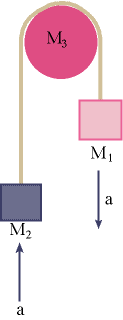Atwood Machine
 The
Atwood machine consists of two masses (M1 and
M2) connected via a rope running over a pulley (mass
M3 - only comes into play in the case with friction). In
the friction-free case, the pulley does not move, and the rope just
glides over it. In the presence of friction, the pulley is set into
rotation, and the energy of rotation must be taken into account - as
described in a later chapter.
The
Atwood machine consists of two masses (M1 and
M2) connected via a rope running over a pulley (mass
M3 - only comes into play in the case with friction). In
the friction-free case, the pulley does not move, and the rope just
glides over it. In the presence of friction, the pulley is set into
rotation, and the energy of rotation must be taken into account - as
described in a later chapter.
Let's consider the friction-free case with M1 >
M2. In this case the acceleration will be as shown in the
diagram. (The formula derived below is correct for any case; if
M1 < M2, then the acceleration, a, will come
out with a negative sign.) The total gravitational force is
(M1 - M2) g
since the weight-force of M1 mass acts in the direction
of the acceleration, a, but the weight of M2 acts in the
opposite direction. The total mass that has to be accelerated is
(M1 + M2). So F = ma has the form:
F = m a =>
(M1 - M2) g = (M1 + M2) a
=>
\[ \rm \mathbf {a = \frac{g(M_{1} - M_{2})}{M_{1} + M_{2}}} \]
From this equation you can see that the acceleration, a, in this
case is always smaller than g. If both masses are equal, then we
obtain the expected result of 0 acceleration. By selecting the proper
combination of masses, we can generate any value of the acceleration
between zero and g that we desire.
© MultiMedia
Physics, 1999
 The
Atwood machine consists of two masses (M1 and
M2) connected via a rope running over a pulley (mass
M3 - only comes into play in the case with friction). In
the friction-free case, the pulley does not move, and the rope just
glides over it. In the presence of friction, the pulley is set into
rotation, and the energy of rotation must be taken into account - as
described in a later chapter.
The
Atwood machine consists of two masses (M1 and
M2) connected via a rope running over a pulley (mass
M3 - only comes into play in the case with friction). In
the friction-free case, the pulley does not move, and the rope just
glides over it. In the presence of friction, the pulley is set into
rotation, and the energy of rotation must be taken into account - as
described in a later chapter.